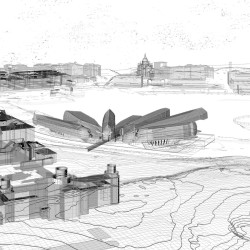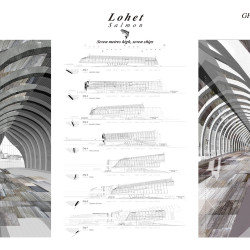A single typological model, the terminal, has taken precedence in the contemporary design of public buildings: mere shopping corridors, as sterilized as they are devoid of any real agonistic substance. A museum, just like an airport, is today more than ever something to be consumed. In the same way, any artistic movement dies when entering that sanctuary (and occupies its place in history); the container itself is also neutralized and ends up being part of the exhibit.
_
The Solomon R. Guggenheim Foundation has promoted museums which both sustain and deny this model, genuine game-changers in the cities where they have settled. It follows that Helsinki should host a new Guggenheim in more ways than one, and do so through a global happening which also establishes specific local relationships.
Lohet, like a salmon in a river, is a story which goes upstream. From the Indian Ocean to the Baltic Sea, two different geographies are connected: the new Guggenheim is born 7,000 km from its site in Chittagong (Bangladesh), the biggest ship graveyard in the world. Lohet starts there, rescuing seven ships of different length, to sail back again and head towards the South harbour of Helsinki, Eteläsatama.
Lohet is a hybrid, and soon adapts to its new environment. After docking, and right before the public gaze, the hulls are turned upside down and modified in search of a new existence. We take advantage of their structural performance as beams to create great galleries raised from the ground and focusing on different panoramas, such as the Uspenski cathedral or the touristic ferries. The site is therefore freed from use and the resulting lansdcape is treated as an extension of the Observatoriebergets park, now connected to the sea.
Lohet also reveals a new environmental sensitivity. Recycling big structures is a way to reduce the carbon footprint in construction. Re-using tons of waste that are scrapped in the poorest conditions is also related to a socio-economic dimension of sustainability. The building process of the Museum should turn into a global, emphatetic and cultural event.
The hull of the ship is treated as a whole, not just as an envelope. A section is not just a vertical cut through an element. It is a condition, a relationship between the components of a building. In our case, a climatic relationship. When implementing the aforementioned partition strategy, we had already generated several levels of hot air by means of a displacement ventilation system.
The air is not climatized. It`s people and works of art that are climatized
The hypocaust -or protoradiant floor- a geothermal temperature control and a Bore-through airflow, related to the wind and with exposed façades 60-120 m long, are included in the design of the building.
Closed endings represent the urban equivalent of the end of entropy, a thermal death. If current social and economic circumstances have made us aware of new sensibilities, maybe it is now time for a new aesthetic of reversibility, of uncertainty and genuine affect towards the upcoming cultural equipment.
_
Lohet
{salmo salar}
Salmon
Manuel Ocaña
Miguel Molins
Yolanda Herranz
Enrique Encabo
Inmaculada Maluenda
Estefanía Batista Flores

















